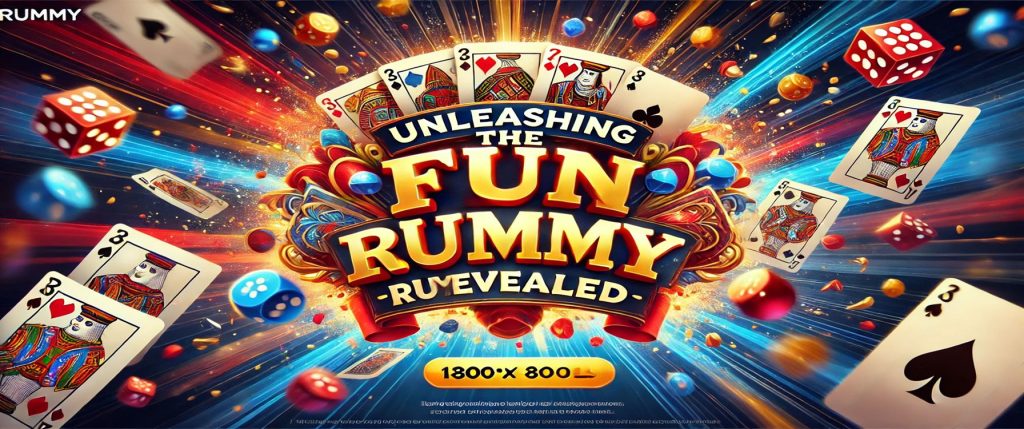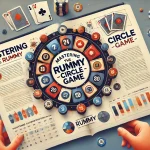Description

The Complete Guide to Rummy The card game rummy has been engaging players for centuries & has a long and diverse history dating back to the early 1800s. Despite some ambiguity surrounding its exact origins, it is generally accepted that the game developed from earlier card games like the Mexican-originated Conquian. Conquian is frequently considered the forerunner of contemporary rummy due to its comparable card-melding & discarding mechanisms.
The wide variety of rummy variations that exist today is the result of the game’s multiple adaptations as it traveled across borders. Rummy arrived in the United States by the late 1800s and quickly became very popular there, especially among families and social circles. As rummy developed further, it gave rise to a number of variations, each with its own set of strategies and rules.
As a cheap source of entertainment during hard economic times, the game became a mainstay in American homes during the Great Depression. The popularity of rummy continued to rise in the 20th century after Gin Rummy was introduced in the 1910s, making the game easier to play and more widely available. Its status in American culture was cemented when this version swiftly gained popularity among players and was even highlighted in mainstream media. Rummy is now played all over the world, with innumerable adaptations and variations that take into account regional tastes and customs, making it a genuinely global pastime.
Rummy requires a mix of strategy, skill, and a little bit of luck to play. Forming sets or runs of cards is the aim of the game, which can be accomplished by drawing and discarding cards from a central pile. Although some variations may use extra decks or jokers, rummy is usually played with two to six players using a standard 52-card deck. A certain number of cards—typically seven or ten, depending on the variation being played—are dealt to each player.
The draw pile consists of the remaining cards, and the discard pile is initiated by placing the top card face-up. Before discarding one card from their hand, each player takes a turn drawing from the draw or discard pile. The game goes on until a player discards their last card after successfully combining all of their cards into runs or sets. Three or more consecutive cards of the same suit make up a run, whereas three or four cards of the same rank but different suits make up a set. In many variations, players receive points for successfully melding cards while facing penalties for unmelded cards left in their hands when another player leaves. However, scoring can vary depending on the exact rules being followed.
Players of all ages and skill levels can enjoy the captivating game of rummy because it combines strategy and chance. Many variations of rummy have been created to accommodate a variety of tastes and playing styles. Gin Rummy is one of the most well-liked variations, emphasizing deft play and calculated choices.
Players in Gin Rummy try to minimize the value of the unmelded cards in their hands while forming melds. Usually, the game is over when one player hits a set score, usually 100 points. Another popular variation is Indian Rummy, which uses two decks of cards and permits more intricate melds with jokers acting as wild cards. This version has its own set of special rules that improve gameplay and is especially well-liked in South Asia. Other noteworthy variations include Canasta, which blends aspects of rummy with card melding; Contract Rummy, where players must fulfill certain contracts in each round before moving on to the next; and Kalooki Rummy, which adds extra rules about wild cards & scoring.
While keeping the fundamental ideas that make up rummy, each variation adds a unique flavor to the game. Regardless of whether they prefer fast-paced games or ones that call for more complex strategic thinking, players can find a version that fits their tastes thanks to this variety. Players need to gain a deep comprehension of psychology and strategy in order to succeed at rummy. Keeping a close eye on the cards your opponents discard is a crucial piece of advice.
This can give you important information about their hand and assist you in deciding which cards to keep or discard. Also, you can gain an advantage in anticipating your opponents’ moves and possibly preventing them from accomplishing their objectives by monitoring which melds they are attempting to execute. Managing your hand effectively is another successful tactic.
The goal is to make melds as fast as you can while reducing the quantity of valuable cards that remain unmelded in your hand. If another player wins before you, this lowers your possible penalty points in addition to increasing your chances of going out first. Holding onto high-value or wild cards until you can use them successfully in a meld is another option.
These tactics, along with attentive observation and flexibility, can greatly increase your chances of winning at rummy. In addition to being a game, rummy is a social activity that helps players build relationships. Rummy offers an opportunity for people to connect through friendly competition and shared experiences, whether it is played at parties, family get-togethers, or informal get-togethers with friends.
Everyone can play and have fun in this inclusive environment because of the game’s comparatively easy rules, which make it accessible to beginners while still providing depth for more experienced players. Also, rummy promotes player interaction and communication. In the process of playing games, players build relationships and make enduring memories as they converse about tactics or joke around. Rummy is a beloved tradition in many cultures because of its social component, which goes beyond simple play and frequently includes snacks, beverages, & laughter.
Rummy acts as a link between generations in this way, enabling families to transmit not just the game’s rules but also experiences and tales that strengthen their bonds. As rummy’s appeal has increased over time, so too have competitions and tournaments devoted to this cherished card game. Players from different backgrounds gather at these events to display their abilities and vie for rewards or recognition among other rummy players.
Local events hosted at community centers or major international tournaments with top players competing for sizable cash prizes are examples of tournaments. By taking part in rummy tournaments, players can improve their skills & make new friends who are as passionate about this age-old game as they are. Participants can test their skills against a variety of opponents with varying playing styles in many tournaments that adhere to particular rummy formats or variations.
Also, as players exchange strategies and advice while vying for victory, these events frequently promote camaraderie among participants. Playing games like rummy has a number of cognitive & psychological advantages that enhance general wellbeing. Rummy demands strategic planning, critical thinking, and memory retention—all of which improve cognitive function & mental stimulation. Over time, playing these kinds of games on a regular basis can help you become more focused and develop your problem-solving skills. Also, by offering a fun diversion from the stresses of everyday life, rummy is a great way to reduce stress.
Playing with loved ones can generate social interactions that improve mood & a sense of community. Also, when players have successful or skill-improving moments, friendly competition can increase self-esteem. In general, playing rummy as part of one’s leisure activities can improve emotional fortitude and mental agility. In addition to becoming a popular card game, rummy has become a cultural phenomenon that is represented in a variety of media. References to rummy in both modern television series and classic movies frequently emphasize how it serves as a social activity that unites characters during competitive or friendly moments.
For example, during crucial plot points in many films, characters play tense rummy games, demonstrating how the game acts as a setting for character interactions. Rummy has also served as the inspiration for a large number of mobile applications and internet platforms that let users play the game virtually with friends or complete strangers anywhere in the world. Rummy has become even more popular among younger generations who might not have otherwise been exposed to traditional card games in person thanks to these digital adaptations.
Because of this, rummy is still a popular game that develops with technology and remains a beloved interest in a variety of cultural contexts. To sum up, rummy is a complex game that incorporates social interaction, strategy, history, health advantages, & cultural significance. It is more than just a simple card game.
Its capacity to unite people while intellectually challenging them is what gives it its enduring appeal, guaranteeing its place in homes and hearts across the globe for many generations to come.


